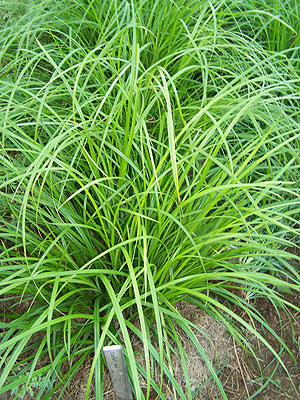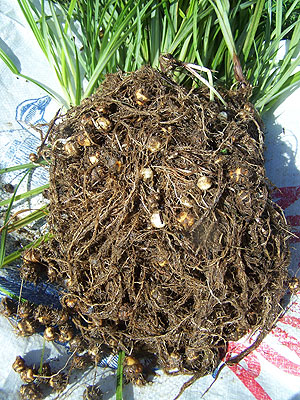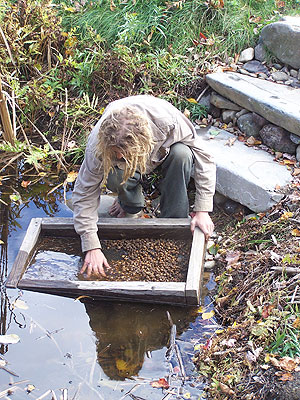 |
| Starting from a single shoot, chufa soon forms a sedgey clump. John Paul Rietz photo. |
By Will Bonsall
Many years ago I dabbled with a new crop I found in the novelty section of a seed catalog: chufa, or nutsedge (Cyperus esculentus). Doubting it would crop well in Maine, I planted some anyway. The results weren’t impressive: I got quite a few small, hard tubers that were less that half the size of those I planted. Still, they tasted promising once cleaned of all the grit, so I put them on my list of things to try again “someday.”
“Someday” turned into last summer, when I revisited a number of old experiments, mostly in preparation for a large book I’m writing. This time I had vastly greater success, and I will definitely include chufa in my garden and diet in the future.
This “new crop” was eaten by the ancient Egyptians. I’m not certain it was cultivated, but I can imagine it thriving in the warm silty delta soil of Egypt. Today in Louisiana chufa forms a perennial border around some lakes and bayous. Farther north it cannot survive to become invasive as it is in other parts of the country; instead it has to be replanted every year. In modern times chufa is planted in the southeast United States for one purpose only: “wildlife enhancement.” It’s grown to attract and fatten wild turkeys so that landowners can sell hunting permits to their land. On fields that can be flooded, it’s also grown to attract wild ducks and other waterfowl.
I want to attract wild turkeys about as badly as I want to attract potato bugs, and I have no interest in wasting crops on such second-hand food; I want to eat the chufa itself, especially since it contains many nutrients that don’t end up in the turkey meat.
Growing Chufa
At Lassiter Farms in northeastern North Carolina, Donny and Ethlene Lassiter produce tons of the oily (17 percent) tubers for seed. (See www.cypruskneechufa.com/cypruskneeproducts.html) I needed only a pound or two and they kindly obliged: Donny sent me a whole bushel for what couldn’t have even covered the shipping cost. (Please don’t order less than a bushel from them; I’d hate to see these nice folks go out of business by their own generosity.) Though sold for seed, the tubers were cleaned to nearly food grade, so I’ve had plenty to experiment with while waiting for my own crop to mature. Ethlene told me she had never eaten chufa and never knew anyone to eat them except as turkey meat.
Chufa requires moderate fertility, good weed control and adequate moisture. All were lacking my first time around, 30-some years ago. This time I gave each of two 6- x 40-foot beds three large wheelbarrows full of veganic compost. The plot was already in good tilth, but not worked as deeply as I wished, so we dug it deeply and removed rocks down to about 14 inches. This of course brought up lots of subsoil and thinned out the old topsoil, so we waited to add compost, lest it get buried too deeply, plus I added a few gallons of dry wood ash.
I gave some seed to a friend to try growing, and her row was completely cleaned out in a single night, we assumed by raccoons, but squirrels and wild turkeys and other critters know a good thing when they find it. I laid a roll of hex-wire over most of my beds to thwart diggers. I didn’t lose a single seed – but the unprotected seed was also unbothered, so my results may have been a fluke.
 |
| A single chufa plant may have 50 to 100 tubers. Will Bonsall photo. |
We also started some plants in celled seedling trays a few weeks early, and pre-soaked some seed tubers the day before planting, while planting the rest dry in early June, as chufa will not abide frost. Those started in seedling trays yielded best; the difference was not huge but enough to justify the bother, plus transplanting thwarts wildlife.
We mulched almost immediately with shredded leaves, so weed control was excellent. We watered a few times, but considering how hot and dry the season was, we surely could have used more. Perhaps the mulch made up for that, but in any case the plants flourished and spread; where single shoots had originally emerged, clumps soon filled the space between them, much as grains and other grasses form a “stool” by “tillering,” each new shoot forming tubers at its base.
Harvesting and Cleaning
To see how chufa might intercrop with a legume, I tried chickpeas, a crop I had hitherto always grown by itself. At first they got on well together, with rows 12 inches apart and plants 12 inches apart within rows, but later the chufa crowded the chickpeas somewhat and yield was poor; crowding may have been a factor, but I sooner suspect red squirrels.
Just before the Common Ground Fair, we dug a few chufa test plants and were excited to find well over 50 tubers per plant, fully as large as those we’d sown. So far we had invested very little effort in growing and harvesting them, but postharvest processing was not so simple. The tubers were held in a stringy mass of soddy roots, along with lots of mud and pebbles. We experimented to find the most labor-efficient way to clean them. Our favorite was to spread tubers on an elevated rack of poles and chicken-wire held over a plastic tarp. After plants dried for a few days, we grabbed them by their “scalps” and rubbed and shook them roughly back and forth on a coarse screen. As the tubers and dirt sifted through, we picked off the “clingers” by hand.
Then we took the whole mess to our farm pond, where we put the tubers on a 2- x 3-foot, 1/4-inch mesh screen that I ordinarily use to sift compost for potting mix. We submerged it and stirred it around, and most of the dirt – now mud – washed through, leaving nearly clean tubers and a few pebbles. After further drying and draining, we spread the tubers on nylon drying screens, on rails that hang from our ceiling. After a few days’ curing, we picked them over and weighed out 14 pounds from 140 feet of row. (Due to the shape of the bed, two rows were foreshortened from the usual 40 feet.)
 |
| Washing the muddy tubers in the farm pond. Will Bonsall photo. |
Horchata de Chufa and Other Uses
What did that 14 pounds consist of nutritionally? We knew from previous tasting that they are delicious, evocative of almonds (some say filberts, coconuts or Brazil nuts) – after all they are 17 percent fat. But as I chew them, I become increasingly aware of a fibrous after-feel in my mouth. Most find this unobjectionable, but I find it a little off-putting, at least if I wish to eat these things as a staple, not merely a snack. That’s when I began to investigate other ways of eating them, such as “horchata.”
There is still one place in the world where chufa is appreciated as human food, and that is the Spanish region of Valencia. Keep in mind that farmers there also grow the excellent Valencia peanut, so they can afford to be choosy, yet they make at least two foods from the chufa: a roasted snack they export to us as “tiger nuts” (don’t even ask) and a delicious chilled milk-like beverage called “horchata”(the “h” is nearly silent). If people in our country say they’ve had horchata, they usually mean a product of Mexico that is made from rice; real Spanish horchata from chufa is a completely different product.
We tried my own invention, with mixed results: I ground raw dry chufa tubers into fine flour (even sifting it) and added about 1 part chufa flour to 6 or 7 parts boiling water, simmered it a few minutes, then cooled and strained it. Or tried to – but cooking makes it a bit gummy and difficult to get through a wire strainer, let alone a fine cloth. However that did give me the idea of mixing chufa meal with cornmeal (1:4 at most) for a delicious porridge. (I also add terrasol, or sunchoke meal, and/or mashed squash and/or peanut butter, any of which is an improvement.)
We also tried a more traditional method: soaking tubers overnight, then blending them uncooked with cold water (again about 1:6) before straining through a cloth, adding sugar, cinnamon and lemon peel, then chilling for an hour or more. This proved very tasty, like almond or coconut milk. The leftover pulp usually goes to waste, so I prefer the porridge recipe described above. Chufa horchata also makes very tasty but heavy cornbread.
I’m also experimenting with using chufa flour in cooking, either raw or roasted, like almonds. First I crack chufa very coarsely in my Corona mill and let it further dry for a day or so; then I further grind the meal into a fine product, not quite tight enough to gunk up the grinder plates. Then I sift it and add it to cornmeal, using less than 1/4 chufa. Alternately I make that quarter-portion part chufa and part terrasol (sunchoke) flour. This makes a truly delicious breakfast porridge.
Beyond excellent flavor, chufa intrigues me for a couple of other reasons. Chufa is a different kind of food: Many food tubers are starchy, but these are really more like an oil-seed, more like peanuts but a lot easier to grow here. And although I can make dairy analogs –“milks” – from soybeans and sunflower seeds, the greater nutty sweetness of horchata is a natural for serving on hot or cold cereal.
In addition to being a different kind of food, chufa is also a different kind of crop on the land. It is after all a monocot (like grains, asparagus and the onion family) and plays a different ecological role on the land. In particular, the sedges (which chufa is) have the rather rare ability to “eat the rocks,” that is, to take minerals (notably silica) directly from inorganic soil and “organicize” them – turn them into a soluble form that higher plants need, but are not so good at “mining” for themselves. As such, chufa makes a useful contribution to soil and plant health, and aside from its esteemed place on my table, that is plenty of reason to keep growing it.
Seed Sources
SeedworldUSA, 4117 Gunn Hwy., Tampa, FL 33618 (only U.S. source to sell small amounts)
Thomas Farms, 6220 Tall Pine Rd., Jay, FL 32565 (50 pounds only)
Dan Brisebois/Tournesol Farm, 1025 ch. St.-Dominique, QC J7T 1P5 (Canada only)
I can supply a limited amount at $5/pound while it lasts. I still have 30-plus pounds left from North Carolina.
About the author: Will Bonsall directs Scatterseed Project, a seed saving enterprise. Contact him at Khadighar, 39 Bailey Rd., Industry, ME 04938.
